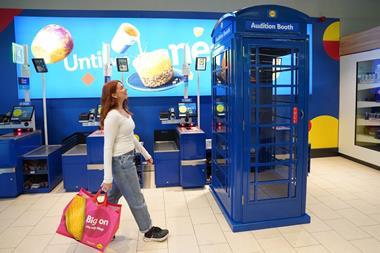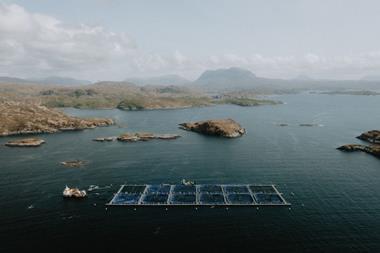The introduction of energy-efficient initiatives by the multiples was always going to generate good PR. But the main driver is commercial, says Glynn Davis
Ever since the cost of energy started to rocket, supermarkets have been looking at ways to cut costs and maximise energy usage. With some doomsayers now predicting acute fuel shortages as early as 2008, attention has also turned to more extreme solutions - including energy-saving superstores.
Sainsbury started the ball rolling in 1999 with its first ‘green’ outlet on the Greenwich Peninsula, east of London. Tesco followed, in November last year, with an outlet in Diss, Suffolk. Asda will join the party later this year with plans to open its first eco-store. And in the US, Whole Foods Market has just gone one step further, converting all of its energy use to green sources in a move that will cut carbon emissions by the same amount as taking 60,000 cars off the road for a year, says the US Environmental Protection Agency.
David Shirley, director of global sustainability services at KPMG, says: “Lots of people have used energy saving as good PR, but it is highly unlikely that a company would go to such lengths just for that. Cost reduction is the key business driver.”
Ian Bowles, head of social corporate responsibility at Asda, agrees: “Energy efficiency is central to mitigating our costs.”
To put the costs into perspective, Bowles says Asda spends about £96m a year on electricity, while the price of gas has increased from 40p per therm last year to 170p. Add to this the fact that the Climate Change Levy is also hitting retailers in the pocket and there is clearly a need to act.
As well as installing energy-saving devices such as dimmer switches, using variable mortars on new stores and looking at on-site renewable energy sources, Asda plans to implement some of the lessons from the two environmentally friendly Wal-Mart stores that opened last year in the US, says Bowles.
There are also plans to install wind turbines at five of its distribution centres. These are expected to provide 5% of its total energy needs. Such initiatives will contribute to Wal-Mart’s stated aim of reducing carbon emissions by 20% by 2007. Sainsbury, like Asda, was advised by the Carbon Trust, and also set itself targets to reduce emissions through energy-saving activities. It has successfully reduced them across 500 stores by 11% since 2001 through a number of initiatives, including overhauling its refrigeration systems and improving its lighting. This has helped it to reduce its annual energy bills by more than £8m.
Julius Brinkworth, group energy manager at Sainsbury, says: “The savings achieved met our corporate commitments on energy emissions. This was important both for our environment targets and for cost savings.”
The company is aiming to reduce emissions per square metre of floor space by another 5% before April 2008 through existing and new, as yet unidentified, projects.
Although energy-saving programmes come at a price (£14m for Sainsbury) the payback period is typically less than three years. This was the case for Sainsbury and Tesco hopes to achieve the same at Diss.
Jenny Sacre, Tesco’s environment communications manager, says: “It’s a total business decision. We save money in the long term, but there is a short-term cost. It’s the first time we’ve pooled all our efforts and whacked them into one store. We’ll see if we can achieve 20% savings.”
The Diss store is a trial to see what works in the retail environment. Like Whole Foods Market and Asda, Tesco has plumped for wind power as a key source of renewable energy. The Diss store features five roof-fitted wind turbines that provide sufficient electricity to power all 15 tills as well as modified chilled storage to reduce cool air loss and energy-efficient bakery ovens.
Tesco is also looking at using bio-fuels as they cost no more than traditional fuels once the investment has been made for the necessary infrastructure. Sacre says: “We know we should be doing it and we know it saves money in the long run.”
These energy-saving initiatives are not just the result of listening to the customer, as Sacre explains: “The customer view is very much what they can touch and see, so at Diss we have introduced more recycling facilities and from the end of the year all our carrier bags will be biodegradable. The rest is a business decision, but it does show that our concerns are more than just carrier bags.”
Tesco is already working on the next stage of its energy-saving programme and plans to open a new outlet in Swansea this summer that will use special building techniques and have more energy-efficient insulation,
as well as utilising solar panels and recycled water.
It is also planning its biggest ever mixed-used development, in Tolworth, Surrey, which it claims will cut carbon dioxide emissions by 50%. The scheme will also use recycled rainwater for the toilets and solar panels, recycled heat from refrigeration units and energy created from organic waste.
Waitrose too has been making changes to its stores, says Bill Wright, energy and environment manager. “Our building group strives to reduce the energy used by our buildings both in use and construction. We carry out life-cycle costing and I am tasked with ensuring that the building process and materials used are efficient.”
This, combined with in-store energy-saving projects, has enabled Waitrose to increase its efficiency by 5% in the short term and more is expected in the medium term. Wright says the group’s target is to reduce CO2 emissions by 10% by 2010, based on the business’s trading pattern in 2000.
While Robin Webster, supermarkets campaigner at Friends of the Earth, commends such actions, she would like to see legislation force the major grocers to incorporate energy-saving elements into new stores, rather than on a voluntary basis.
“Although we have the top-level Planning Policy Guidance there is also a lot of local choice, so local authorities have the opportunity to include energy-efficient demands when they rewrite their local development frameworks,” she says. But she remains sceptical of the multiples’ motives.
“We welcome things such as wind turbines, but with the huge increases in the numbers of hypermarkets being built in the UK it’s like rearranging deckchairs on the Titanic. Their sheds put them in a bad way in the first place. The supermarkets need to fundamentally change their structures.”
However, KPMG’s Shirley appreciates why the multiples have not been quite so gung ho in their energy-efficiency activities as Friends of the Earth would like. “In food retail, energy consumption is not one of the main sustainability issues: it’s more important from the operational aspect,” he says.
“It’s good to see food retailers doing something about energy, but is it the biggest issue for them? I think not, compared with, say, an ethical supply chain. They have been more reactive than proactive, probably because their drivers on CSR are not as clear as they are, say, for a mining or oil company.”
If recent activity is anything to go by, that may not be the case for much longer.
Ever since the cost of energy started to rocket, supermarkets have been looking at ways to cut costs and maximise energy usage. With some doomsayers now predicting acute fuel shortages as early as 2008, attention has also turned to more extreme solutions - including energy-saving superstores.
Sainsbury started the ball rolling in 1999 with its first ‘green’ outlet on the Greenwich Peninsula, east of London. Tesco followed, in November last year, with an outlet in Diss, Suffolk. Asda will join the party later this year with plans to open its first eco-store. And in the US, Whole Foods Market has just gone one step further, converting all of its energy use to green sources in a move that will cut carbon emissions by the same amount as taking 60,000 cars off the road for a year, says the US Environmental Protection Agency.
David Shirley, director of global sustainability services at KPMG, says: “Lots of people have used energy saving as good PR, but it is highly unlikely that a company would go to such lengths just for that. Cost reduction is the key business driver.”
Ian Bowles, head of social corporate responsibility at Asda, agrees: “Energy efficiency is central to mitigating our costs.”
To put the costs into perspective, Bowles says Asda spends about £96m a year on electricity, while the price of gas has increased from 40p per therm last year to 170p. Add to this the fact that the Climate Change Levy is also hitting retailers in the pocket and there is clearly a need to act.
As well as installing energy-saving devices such as dimmer switches, using variable mortars on new stores and looking at on-site renewable energy sources, Asda plans to implement some of the lessons from the two environmentally friendly Wal-Mart stores that opened last year in the US, says Bowles.
There are also plans to install wind turbines at five of its distribution centres. These are expected to provide 5% of its total energy needs. Such initiatives will contribute to Wal-Mart’s stated aim of reducing carbon emissions by 20% by 2007. Sainsbury, like Asda, was advised by the Carbon Trust, and also set itself targets to reduce emissions through energy-saving activities. It has successfully reduced them across 500 stores by 11% since 2001 through a number of initiatives, including overhauling its refrigeration systems and improving its lighting. This has helped it to reduce its annual energy bills by more than £8m.
Julius Brinkworth, group energy manager at Sainsbury, says: “The savings achieved met our corporate commitments on energy emissions. This was important both for our environment targets and for cost savings.”
The company is aiming to reduce emissions per square metre of floor space by another 5% before April 2008 through existing and new, as yet unidentified, projects.
Although energy-saving programmes come at a price (£14m for Sainsbury) the payback period is typically less than three years. This was the case for Sainsbury and Tesco hopes to achieve the same at Diss.
Jenny Sacre, Tesco’s environment communications manager, says: “It’s a total business decision. We save money in the long term, but there is a short-term cost. It’s the first time we’ve pooled all our efforts and whacked them into one store. We’ll see if we can achieve 20% savings.”
The Diss store is a trial to see what works in the retail environment. Like Whole Foods Market and Asda, Tesco has plumped for wind power as a key source of renewable energy. The Diss store features five roof-fitted wind turbines that provide sufficient electricity to power all 15 tills as well as modified chilled storage to reduce cool air loss and energy-efficient bakery ovens.
Tesco is also looking at using bio-fuels as they cost no more than traditional fuels once the investment has been made for the necessary infrastructure. Sacre says: “We know we should be doing it and we know it saves money in the long run.”
These energy-saving initiatives are not just the result of listening to the customer, as Sacre explains: “The customer view is very much what they can touch and see, so at Diss we have introduced more recycling facilities and from the end of the year all our carrier bags will be biodegradable. The rest is a business decision, but it does show that our concerns are more than just carrier bags.”
Tesco is already working on the next stage of its energy-saving programme and plans to open a new outlet in Swansea this summer that will use special building techniques and have more energy-efficient insulation,
as well as utilising solar panels and recycled water.
It is also planning its biggest ever mixed-used development, in Tolworth, Surrey, which it claims will cut carbon dioxide emissions by 50%. The scheme will also use recycled rainwater for the toilets and solar panels, recycled heat from refrigeration units and energy created from organic waste.
Waitrose too has been making changes to its stores, says Bill Wright, energy and environment manager. “Our building group strives to reduce the energy used by our buildings both in use and construction. We carry out life-cycle costing and I am tasked with ensuring that the building process and materials used are efficient.”
This, combined with in-store energy-saving projects, has enabled Waitrose to increase its efficiency by 5% in the short term and more is expected in the medium term. Wright says the group’s target is to reduce CO2 emissions by 10% by 2010, based on the business’s trading pattern in 2000.
While Robin Webster, supermarkets campaigner at Friends of the Earth, commends such actions, she would like to see legislation force the major grocers to incorporate energy-saving elements into new stores, rather than on a voluntary basis.
“Although we have the top-level Planning Policy Guidance there is also a lot of local choice, so local authorities have the opportunity to include energy-efficient demands when they rewrite their local development frameworks,” she says. But she remains sceptical of the multiples’ motives.
“We welcome things such as wind turbines, but with the huge increases in the numbers of hypermarkets being built in the UK it’s like rearranging deckchairs on the Titanic. Their sheds put them in a bad way in the first place. The supermarkets need to fundamentally change their structures.”
However, KPMG’s Shirley appreciates why the multiples have not been quite so gung ho in their energy-efficiency activities as Friends of the Earth would like. “In food retail, energy consumption is not one of the main sustainability issues: it’s more important from the operational aspect,” he says.
“It’s good to see food retailers doing something about energy, but is it the biggest issue for them? I think not, compared with, say, an ethical supply chain. They have been more reactive than proactive, probably because their drivers on CSR are not as clear as they are, say, for a mining or oil company.”
If recent activity is anything to go by, that may not be the case for much longer.













No comments yet